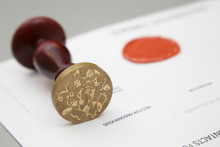Friday, March 11, a dull, rainy day was metamorphosing into an exciting evening. The Vrijhof Agora was rocking to the beat of Indian folk music and dance called bhangra, during a fund raiser organized by AADHAAR, for tsunami rehabilitation efforts in India.
It has been almost three months, since tsunami waves caused an unprecedented catastrophe of devastating ferocity, killing more than 300,000 people, and leaving millions in disbelief and disarray. From all parts of the globe came a unique exhibition of human generosity. Although immediate relief efforts were assured by the international help, long-term rehabilitation of the affected areas still looks a distant milestone.
AADHAAR (An Association for the Development of Health and Academic Awareness), an organization founded by the UT students, decided it was time to respond to the needs of the region. So, the group organized a `Bhangra Night' fund raiser. Bhangra is a lively form of folk music and dance, originating in Punjab, a northern state of India.
After a small presentation about AADHAAR and its tsunami relief activities, the evening rolled on with a live performance on dholdrum (a large two-sided instrument typically played along with dance) and bhangra dance by Punjabi boys from Amsterdam.
Surprised by the good turn out of local Surinam people, Pramod Agrawal, as AADHAAR volunteer declared: `Bhangra Night is more than a fund raiser. Apart from spreading traditional cultural heritage across the borders, it can also serve a bridge for relations between the Indian and Surinam communities.'
`It is a great party, very well organized, I like the food here, it's good and inexpensive,' said Christiano Trionfetti, an Italian PhD student at the UT. Another Italian face commonly seen at Indian parties, PhD candidate Francesca Romana de Risi exclaimed, `It's wonderful to be here, with its vibrant and diverse culture and food, Indian parties are always entertaining. More of these kinds of events should be organized, to spread the flavor of Indian culture, like showing an Indian movie.'
A second dance performance from Punjabi boys set the dance floor on fire, with pure folk music and meandering melodies, some of the enthusiasts from the audience came on stage and started dancing. A few minutes later, more people were on the dance floor than in the chairs.
Sunniva Pram, a Norwegian physiotherapy student at the Hogeschool, says: `Initially I was sitting and trying to learn, but with rhythm and instrumental music in the atmosphere, it was difficult to resist for long. With easy steps and lively moves, bhangra can be a great party dance.'
Not only was it was a fun-filled evening, but all the money collected at the event will go into rehabilitation efforts in tsunami affected areas in India.







